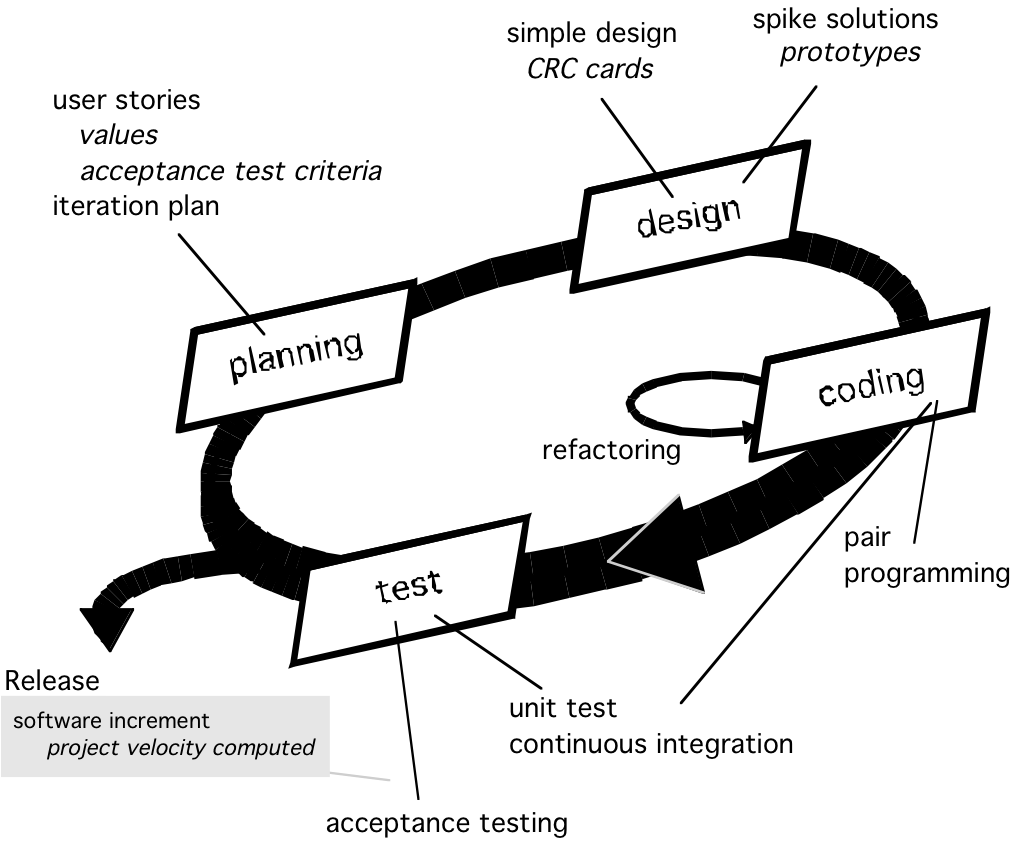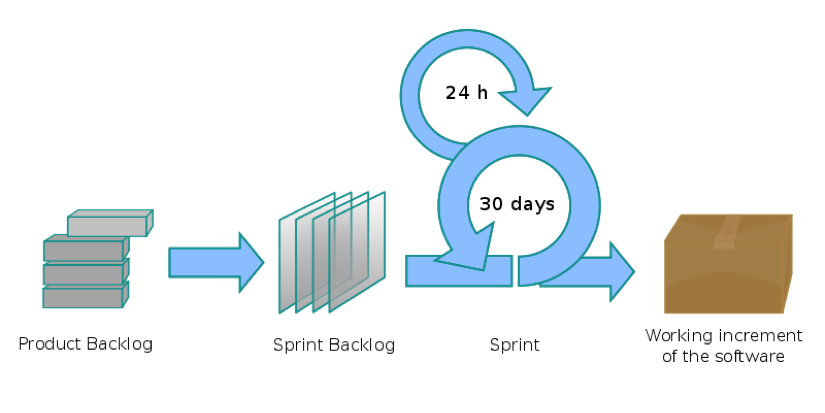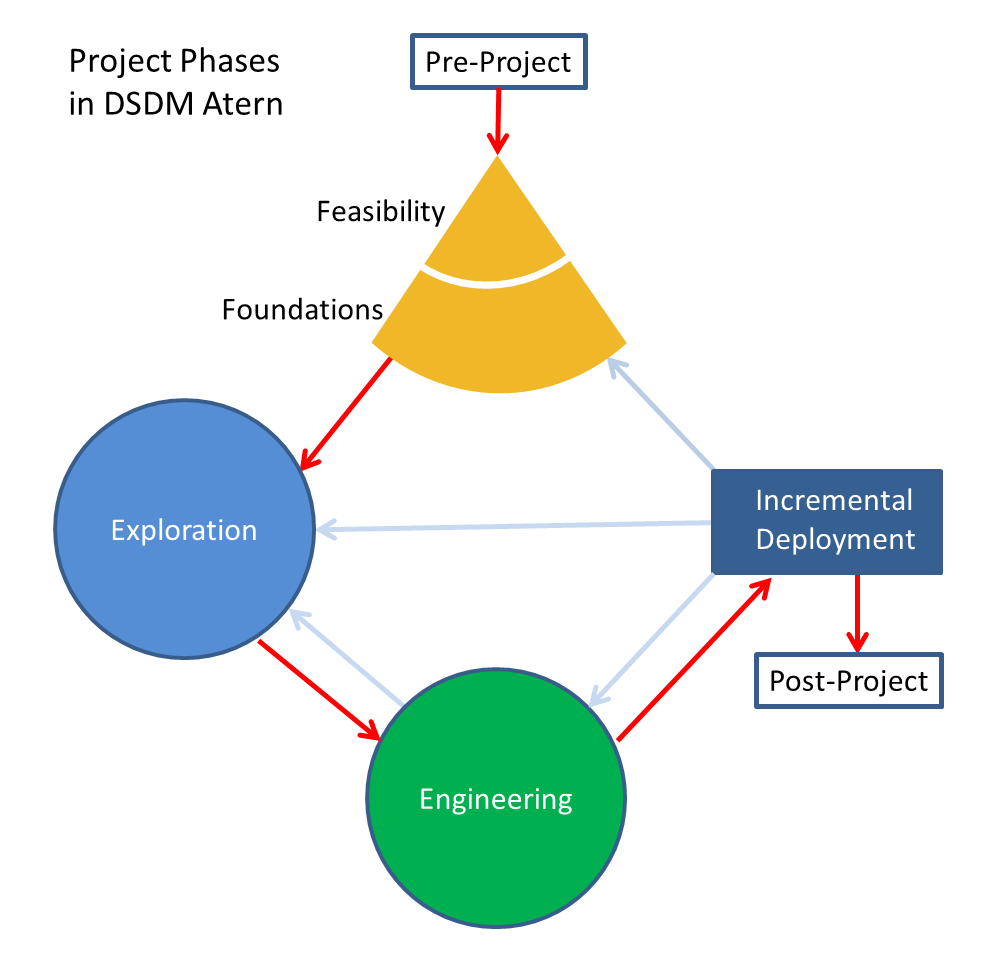CSC/ECE 517 Fall 2011/ch6 6d sk: Difference between revisions
(→Scrum) |
|||
| Line 37: | Line 37: | ||
===Scrum=== | ===Scrum=== | ||
[[File:Scrum_sk.png|400px|right]] | [[File:Scrum_sk.png|400px|right]] | ||
Scrum (derived from a term used in rugby) is an agile process created by Jeff Sutherland in the early 1990s. The basic principles of Scrum are consistent with the Agile Manifesto and serve to guide development. Some of the distinguishing features of Scrum include: | |||
*All development work is partitioned into "packets" | |||
*Testing and documentation are on-going as the product is constructed | |||
*Work occurs in “sprints” and is derived from a “backlog” of existing requirements | |||
*Meetings are very short and sometimes conducted without chairs | |||
*Product demonstrations are delivered to the customer with the time-box allocated | |||
===Dynamic Systems Development Method=== | ===Dynamic Systems Development Method=== | ||
Revision as of 17:02, 16 November 2011
The Agile Landscape
Overview
Traditionally, software has been developed using rigid methodologies such as the Waterfall method of software development. The Waterfall methodology is a set of stages such as - Analysis, Design, Implementation, Testing and Maintenance. These stages follow a strictly linear sequence as mentioned in the last sentence. This method works perfectly well when a project is completely planned, but it has been observed that it is not always the case. The waterfall model is not capable to handle changes requested by the customers when the project has gone deep into the pipeline. In such cases, all the processes have to be followed to incorporate the requested changes, which consumes time and costs dearly to the customer.
Developers who were facing this problem more often started to realize that real world tends to have quite an impact on the development of any process or product. It was time to have a new strategy for software development which was capable enough to overcome the shortcomings of traditional software development methodologies. There are various such methodologies which provide fast and iterative development, ability to handle late changes in requirements and many more features. These methodologies are collectively called as Agile Software Development Methodologies.
The following article provides a brief introduction to Agile Software Development, the various methodologies for agile development, their comparison and some statistics to demonstrate the acceptance and the success rates of agile methodologies.
Introduction to Agile Software Development
In 1990's, software developers started to realize that a planned waterfall approach for software development had many shortcomings and did not facilitate speedy and flexible software development. There were many efforts to devise new methodologies which overcame those shortcomings. These methodologies were called the Agile Methodologies for software development. They allowed developers to adapt to the changes in demands during software development as well as incorporate future changes to the software during any stage of software development.
The agile methodologies are based on iterative and incremental development. In organizations who follow agile development, requirements for a product are formed mainly through collaboration between small teams which are cross-functional and self-organizing. It allows the process of software development to be iterative, time bound, adaptive, evolutionary and flexible. A team learns how to be Agile in the environment provided by the Agile processes. There is more importance to how a team works together, allowing teams to work in a cohesive fashion, increasing the productivity many times. The increase in productivity is such as a team can provide a working software in the first week, and then improve with subsequent iterations.
Agile Manifesto
Agile Methodologies
Extreme Programming

Extreme programming (XP) is a popular approach to agile software development and was created by Kent Beck in 1996. XP is defined by a set of five values that establish a foundation for all work performed as part of development process. These five values are communication, simplicity, feedback, courage, and respect. Each individual value serves as a driver for specific activities, actions, and tasks.
- Communication - XP emphasize close, yet informal communication between customers and developers. This helps ensure effective communication between software engineers and other stakeholders.
- Simplicity - In order to achieve simplicity, XP requires developers to design only for the immediate needs of the project. This results in a simple design that can be implemented easy.
- Feedback - Feedback is received from three sources: software tests, the customer, and other software team members.
- Courage - In order to adhere to certain XP practices, Beck states that is requires courage.
- Respect - By following the other four values, an agile team will develop respect among its members and other stakeholder. As the team begins to achieve success in their delivery of software increments, they will also develop respect for the XP process itself.
XP consists of four framework activities: planning, design, coding, and testing as seen in the figure above. Each phase is summarized in the paragraphs that follow.
- Planning - The initial phase of the process involves the planning game. It is a requirements gathering activity that enables the members of the team to understand the business context for the software and involves listening to the customer. This leads to the creation of a set of user stories that describe the required output, features, and functionality of the software. Each story written by the customer is written on a index card and assigned a value based on its overall business value. Members of the team will then determine a cost (measured in weeks) for each story based on their estimation for how much work would be required to implement the story. The customers and developers will then work together to determine which group of stories will be implemented in the next iteration of the software.
- Design - The design phase of the process involves the creation of a simple design of the system and also provides implementation guidance for each story to be included in the iteration.
- Coding - After a preliminary design for the system is created, the team will then develop a set of unit tests for the system. These tests will serve as guidelines for the developers to focus only on getting the tests to pass and nothing more. One of the defining aspects of XP, involves the pair programming concept. XP recommends that two programmers should work together at one computer workstation to develop code. One person writes the code, while the other will watch and provide feedback. After a period of time, the two programmers will switch their roles.
- Test - In order to place an emphasize on tests, the unit tests generated during the code phase are ran anytime the code is modified to ensure no problems exist in the codebase.
Scrum

Scrum (derived from a term used in rugby) is an agile process created by Jeff Sutherland in the early 1990s. The basic principles of Scrum are consistent with the Agile Manifesto and serve to guide development. Some of the distinguishing features of Scrum include:
- All development work is partitioned into "packets"
- Testing and documentation are on-going as the product is constructed
- Work occurs in “sprints” and is derived from a “backlog” of existing requirements
- Meetings are very short and sometimes conducted without chairs
- Product demonstrations are delivered to the customer with the time-box allocated
Dynamic Systems Development Method
